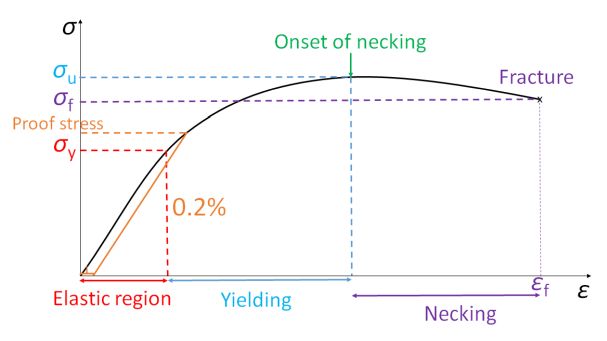Plastic deformation: strength and ductility

Figure 10. A typical nominal stress and strain curve for ductile metal
Let’s come back to the stress-strain curve given by the tensile test and focus on the region beyond a certain stress limit, where the material cannot recover to its original shape. This onset stress limit for plastic deformation to occur is called the yield strength, \( \sigma_y \).
Sometimes the yield point is not well defined, so we will often measure the stress at which a certain amount of plastic deformation has occurred, called the offset yield strength. Proof stress is the point at which the material exhibits 0.2% of plastic deformation.
Strength is the property that measures a material’s ability to withstand plastic deformation.
Ultimate tensile strength (\( \sigma_u \) or UTS) is the maximum stress that a material can withstand while being stretched or pulled before breaking. \( \sigma_u \) indicates the onset of necking. See details in the Mechanical Testing of Metals TLP.
Failure stress or failure strength. \( \sigma_f \) is the stress at which the sample finally fails.
Ductility is a measure of the degree of plastic deformation that has been sustained at fracture. It can be expressed qualitatively as either percent elongation (%EL) or percent reduction in area (%RA).
\[ \%{\rm{EL}} = \frac{l_{\rm{f}} - l_{\rm{0}}}{l_{\rm{0}}} \times 100\% \]
\[ \%{\rm{RA}} = \frac{A_{\rm{0}} - A_{\rm{f}}}{A_{\rm{0}}} \times 100\% \]
Note the percentage elongation is identical to Strain to failure \( \varepsilon_\rm{f} \), i.e., the total strain of the sample at the point of final failure.
Therefore, to summarise, a tensile test allows us to measure the following mechanical properties:
- Young’s modulus, \( E \)
- Yield stress, \( \sigma_\rm{y} \)
- Ultimate tensile strength, \( \sigma_\rm{u}\)
- Failure strength, \( \sigma_\rm{f} \)
- Ductility, as either percent elongation (%EL) or percent reduction in area (%RA)
The plastic behaviour of crystal materials is significantly determined by the linear microstructural defects known as dislocations. Dislocation motion along a crystallographic direction is called glide or slip. For an introduction to dislocation, see here.
Plastic deformation of metals most commonly occurs as a result of the glide of dislocations, driven by shear stresses.

